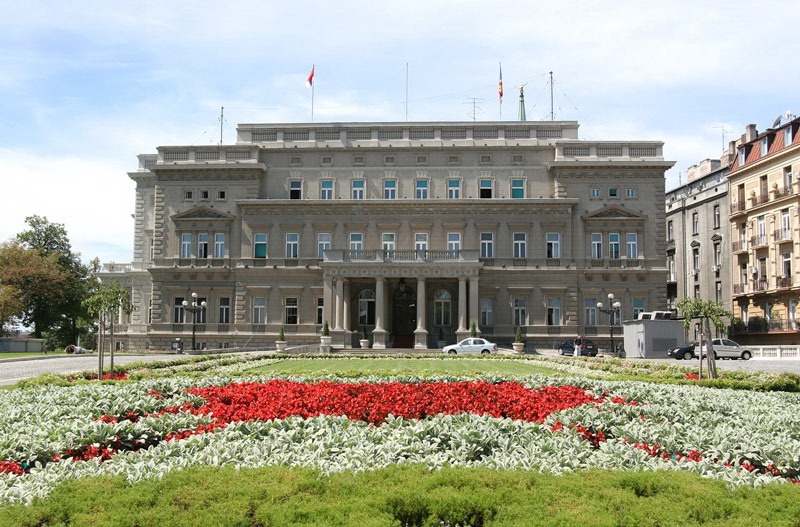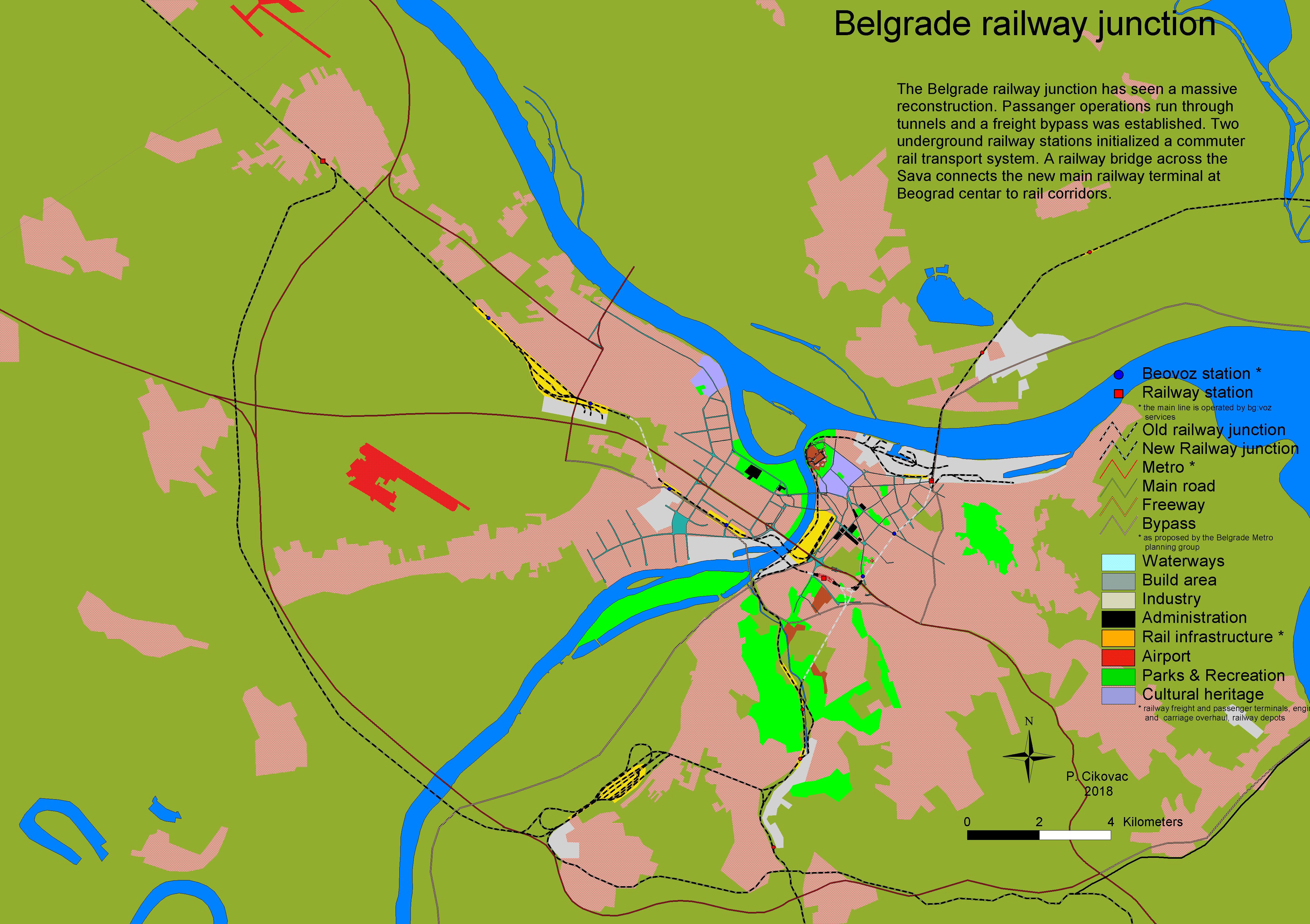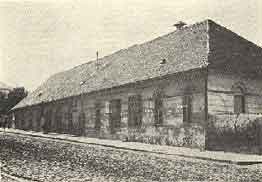|
Branko Pešić
Branko Pešić ( sr-Cyrl, Бранко Пешић, ; 1 October 1922 – 4 February 1986) was a Serbian politician in SFR Yugoslavia. Pešić was a member of the Yugoslav Partisans during the Second World War and was the Mayor of Belgrade from 1964 to 1974. He is widely remembered as one of the most popular Belgrade mayors as his decade-long tenure saw the construction and completion of many important projects. Career Pešić was born on 1 October 1922 in Zemun to father Dimitrije "Mita" (1900–1976) and mother Anka (1897–1983). He completed elementary school in Zemun and high school at the Zemun Gymnasium. After that he studied law at the University of Belgrade. As a student of the Zemun Gymnasium, he joined the youth revolutionary movement and became a member of the League of Communist Youth of Yugoslavia (SKOJ). After the invasion and occupation of the Kingdom of Yugoslavia in 1941, he left his studies and joined the anti-fascist movement in Yugoslavia. He first worked poli ... [...More Info...] [...Related Items...] OR: [Wikipedia] [Google] [Baidu] |
Mayor Of Belgrade
The Mayor of Belgrade ( sr, Градоначелник Београда / ''Gradonačelnik Beograda'') is the head of the City of Belgrade (the capital and largest city of Serbia). The Mayor acts on behalf of the city, and performs an executive function in the City of Belgrade. The position is important as the city is the most important hub of economy, culture, science and technology in Serbia. The current Mayor of Belgrade is Aleksandar Šapić ( SNS). He was elected by the City Assembly on 20 June 2022, following the 2022 City Assembly election. Office According to the current legislation, the Mayor is elected along with members of the City Assembly at the direct secret ballot for the period of four years. The Mayor may not be a councilor of the City Assembly. The Mayor has a Deputy who replaces him/her in case of an extended absence and/or due to any other reasons that prevent the Mayor to perform the duties. The Mayor appoints and dismisses the Deputy Mayor based on th ... [...More Info...] [...Related Items...] OR: [Wikipedia] [Google] [Baidu] |
Nazi Germany
Nazi Germany (lit. "National Socialist State"), ' (lit. "Nazi State") for short; also ' (lit. "National Socialist Germany") (officially known as the German Reich from 1933 until 1943, and the Greater German Reich from 1943 to 1945) was the German state between 1933 and 1945, when Adolf Hitler and the Nazi Party controlled the country, transforming it into a dictatorship. Under Hitler's rule, Germany quickly became a totalitarian state where nearly all aspects of life were controlled by the government. The Third Reich, meaning "Third Realm" or "Third Empire", alluded to the Nazi claim that Nazi Germany was the successor to the earlier Holy Roman Empire (800–1806) and German Empire (1871–1918). The Third Reich, which Hitler and the Nazis referred to as the Thousand-Year Reich, ended in May 1945 after just 12 years when the Allies defeated Germany, ending World War II in Europe. On 30 January 1933, Hitler was appointed chancellor of Germany, the head of gove ... [...More Info...] [...Related Items...] OR: [Wikipedia] [Google] [Baidu] |
Belgrade Railway Junction
The Belgrade railway junction ( sr, Београдски железнички чвор, ) is a large-scale reconstruction of the rail network in Belgrade, Serbia. It was launched 1971 with works officially starting 1974 with the construction of the New Railway Bridge. The central part of the scheme is formed by the Belgrade Centre railway station, better known as Prokop after the neighborhood it is located in, which is served via three tunnels beneath the city center. Construction of the Belgrade railway junction was mostly completed with the opening of the Vukov spomenik underground passenger station in 1995. As the completion of the Prokop railway station was severely delayed due to lack in funding the network, which was planned to replace the old rail network and the historical central station up till today is only used for the BG Voz S-train of the urban modal city network. During World War II, German occupational administration developed a project of Belgrade railway juncti ... [...More Info...] [...Related Items...] OR: [Wikipedia] [Google] [Baidu] |
Beograđanka
The Beograđanka ( sr-Cyrl, Београђанка; , lit. "Belgrade Lady"), officially ''Belgrade Palace'' ( sr, Палата Београд, Palata Beograd, ) is a modern high-rise building in the Belgrade downtown area. A tall structure, it is one of the symbols of the city and representative of the "golden age" in the development of Belgrade during the 1965–1974 mayoral term of Branko Pešić. Location The building is located at the intersection of Kralja Milana (central city street), Resavska, and Masarikova Streets—near the tripoint of the Savski Venac (whose territory the building lies on), Vračar and Stari Grad municipalities. Neighborhoods in the vicinity include Cvetni Trg to the east, Krunski Venac to the northeast, Andrićev Venac to the north, London to the northwest, and Savamala to the west. Three parks are close to the building: Pioneers Park, Manjež and Park Gavrilo Princip. Students Cultural Center and Yugoslav Drama Theater are just east of Beogra ... [...More Info...] [...Related Items...] OR: [Wikipedia] [Google] [Baidu] |
Zeleni Venac
Zeleni Venac ( sr-cyr, Зелени венац) or colloquially Zelenjak ( sr-cyr, Зелењак) is an urban neighborhood of Belgrade, the capital of Serbia. It is located in the Belgrade's municipalities of Savski Venac (major part) and Stari Grad. Location Zeleni Venac is located in downtown Belgrade, just few minutes away to the east of Terazije, the designated center of the city, down the Prizrenska or Sremska streets. It borders the neighborhood of Savamala to the south, while the northern border is Brankova Street which separates it from the neighborhoods of Kosančićev Venac and Varoš Kapija in the municipality of Stari Grad. The car tunnel ('' Terazije Tunnel'') under Terazije connects it to Republic Square while underground pedestrian passage connects it to Terazije and Prince Michael Street via Prizrenska and Sremska streets, respectively. Park Luka Ćelović is on the southeast border of the neighborhood. History Antiquity Northern part of modern neigh ... [...More Info...] [...Related Items...] OR: [Wikipedia] [Google] [Baidu] |
Gazela Bridge
The Gazela Bridge ( sr, Mост Газела, Most Gazela) is the most important bridge over the Sava river in Belgrade, the capital of Serbia. It is a part of the city highway and it lies on European route E75, on the highway passing through the wider city center, connecting Belgrade with Niš to the south, and Novi Sad to the north. The bridge was designed by a group of engineers led by Milan Đurić, and built by the Mostogradnja company. Name The name of the bridge, ''gazela'' is Serbian for "gazelle". Đorđe Lazarević, who was president of the competition commission, said that "this bridge leaped over the Sava like a jumping gazelle", and the name stuck. Already by 1968, two years before the bridge was completed, the name appeared in news reports. In the late 2010s there were proposals to rename the bridge after Branko Pešić, mayor of Belgrade during the bridge's construction, but the name wasn't changed. History By the mid-1960s a need for another road bridge a ... [...More Info...] [...Related Items...] OR: [Wikipedia] [Google] [Baidu] |
Mostar Interchange
Mostar interchange or colloquially Mostar () is a major interchange and a surrounding urban neighborhood of Belgrade, the capital of Serbia. It is located in Belgrade's municipality of Savski Venac. Interchange The Mostar looped interchange was constructed in 1974, as one of two major ones (the other one being Autokomanda) on the highway Belgrade–Niš. The highway runs right through the urban centre of Belgrade, which is still an issue of debate even though the road was originally intended as a fast, intercity Bežanija-Autokomanda freeway. The interchange itself was built on the location of the old neighbourhood of Jatagan Mala. There were two projects for the interchange. One design, by the architects Branislav Jovin and Jovan Katanić, was 10 times more expensive than the other one. Still, after bitter disputes, the mayor of Belgrade Branko Pešić decided in 1967 to go with the expensive project, noting to Jovin and Katanić: "They should prepare three light poles on ... [...More Info...] [...Related Items...] OR: [Wikipedia] [Google] [Baidu] |
Football Association Of Yugoslavia
The Football Association of Yugoslavia (FSJ) ( sr, Фудбалски савез Југославије, Fudbalski savez Jugoslavije, hr, Nogometni savez Jugoslavije; bs, Fudbalski savez Jugoslavije; sl, Nogometna zveza Jugoslavije; mk, Фудбалски Сојуз на Југославија, Fudbalski Sojuz na Jugoslavija) was the governing body of football in Yugoslavia, based in Belgrade, with a major administrative branch in Zagreb. It organized the Yugoslav First League, the Yugoslavia national football team, and the Second Leagues of all six former Yugoslav republics. History It was formed in April 1919 in Zagreb under the name ''Jugoslavenski nogometni savez''. The FA became the temporary member of FIFA on 4 May 1921 and permanent member on 20 May 1923. The name later changed to ''Nogometni savez Jugoslavije''. After disagreements between the Zagreb and Belgrade subassociations in 1929, the Assembly of Football Association of Yugoslavia was dissolved in 1929, subs ... [...More Info...] [...Related Items...] OR: [Wikipedia] [Google] [Baidu] |
National Assembly (Serbia)
The National Assembly ( sr-cyr, Народна скупштина, Narodna skupština, ) is the unicameral legislature of Serbia. The assembly is composed of 250 deputies who are proportionally elected to four-year terms by secret ballot. The assembly elects a president (speaker) who presides over the sessions. Wikisource: Constitution of Serbia The National Assembly exercises supreme legislative power. It adopts and amends the Constitution, elects Government, appoints the Governor of the National Bank of Serbia and other state officials. All decisions are made by majority vote of deputies at the session at which a majority of deputies are present, except for amending the Constitution, when a two-thirds majority is needed.National Assembly of SerbiaInformer (This text is in the public domain as the official material of the Republic of Serbia state body or a body performing public functions, under the terms of Article 6, Paragraph 2 of Serbian copyright law) The assembly convenes ... [...More Info...] [...Related Items...] OR: [Wikipedia] [Google] [Baidu] |
President Of The Presidency Of SR Serbia
The office of the President of the Presidency of the Socialist Republic of Serbia existed from its establishment in the 1974 constitution to its renaming and then total abolishment as part of democratic reforms in 1990. A collective presidency existed in Yugoslavia at the federal level since amendments to the constitution in 1971. On 21 February 1974 a new federal Constitution was adopted which reaffirmed the collective federal presidency chaired by the President of the Presidency. The constituent republics adopted the same system in new constitutions of their own. List of presidents See also *Presidium of Yugoslavia *President of the Presidency of Yugoslavia The office of the President of the Presidency of the Socialist Federal Republic of Yugoslavia ( sh-Latn-Cyrl, Predsjednik Predsjedništva SFRJ, separator=" / ", Председник Председништва СФРЈ, mk, Претседател ... References {{Presidential system of SFRY Socialist Republic of ... [...More Info...] [...Related Items...] OR: [Wikipedia] [Google] [Baidu] |
Central Committee
Central committee is the common designation of a standing administrative body of Communist party, communist parties, analogous to a board of directors, of both ruling and nonruling parties of former and existing socialist states. In such party organizations, the committee would typically be made up of delegates elected at a party congress. In Communist state, those states where it constituted the state power, the central committee made decisions for the party between congresses and usually was (at least nominally) responsible for electing the politburo. In non-ruling communist parties, the central committee is usually understood by the party membership to be the ultimate decision-making authority between congresses once the process of democratic centralism has led to an agreed-upon position. Non-communist organizations are also governed by central committees, such as the right-wing Likud party in Israel, the North American Mennonite Central Committee, Mennonite Church and Alcoholic ... [...More Info...] [...Related Items...] OR: [Wikipedia] [Google] [Baidu] |
Socialist Alliance Of Working People Of Yugoslavia
sl, Socialistična zveza delovnega ljudstva Jugoslavije mk, Социјалистички сојуз на работниот народ на Југославија , named_after = , image = SSRNJ emblem.png , image_size = , caption = Post-1953 emblem , logo = , logo_size = , alt = , motto = , predecessor = , merged = , successor = , formation = August 1945 , founder = , founding_location = , dissolved = 1990 , status = , purpose = , headquarters = Belgrade , location = Socialist Federal Republic of Yugoslavia , region = , services = , methods = , fields = , membership = up to 13,000,000 , membership_year = , language = , sec_gen = , leader_title ... [...More Info...] [...Related Items...] OR: [Wikipedia] [Google] [Baidu] |





